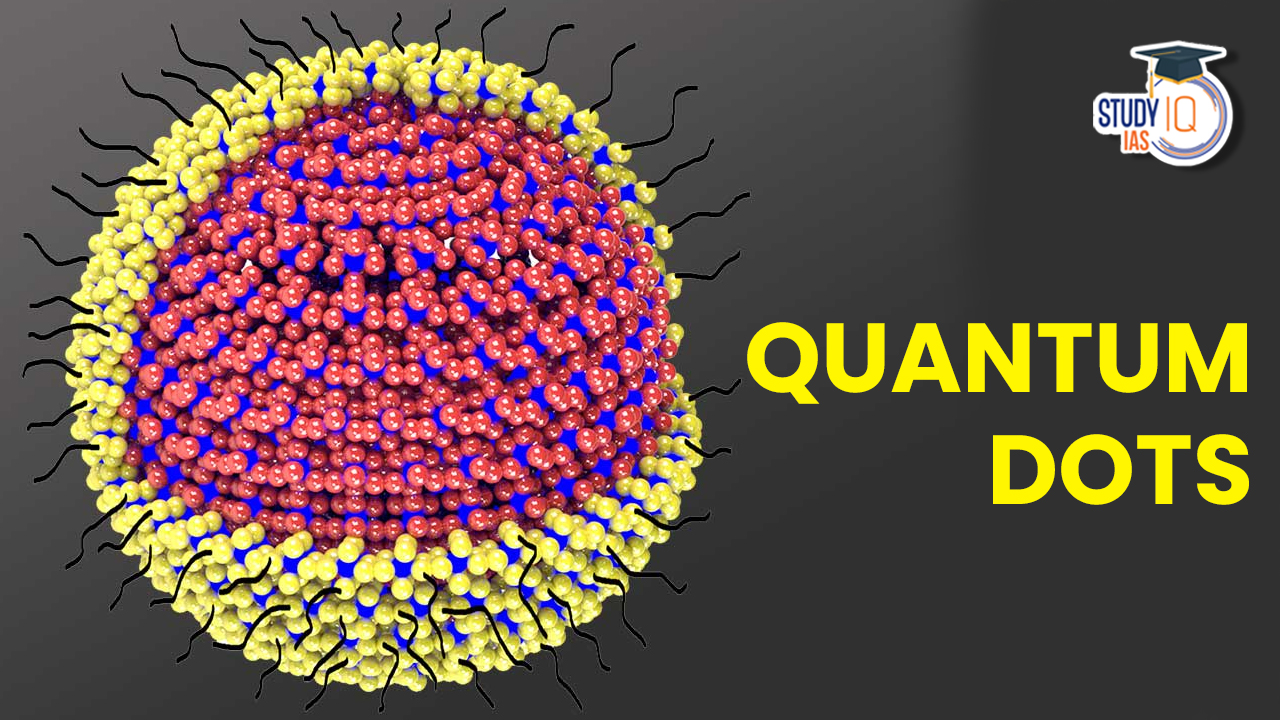Table of Contents
The Royal Swedish Academy of Sciences has awarded the Nobel Prize in Chemistry for 2023 to three distinguished scientists: Moungi G. Bawendi, Louis E. Brus, and Alexei I. Ekimov. Their groundbreaking work revolves around the discovery and synthesis of Quantum Dots, ushering in a new era of scientific exploration and technological innovation.
Quantum Dots
Quantum dots, often likened to “artificial atoms,” are semiconductor nanocrystals that exhibit remarkable quantum mechanical properties. These properties are profoundly influenced by their size, and at the nanoscale, a phenomenon called quantum confinement comes into play.
Quantum dots are primarily composed of elements from the periodic table’s groups II-VI or III-V, like cadmium selenide (CdSe) or indium arsenide (InAs). What sets them apart is their size, which can be precisely controlled during the synthesis process, allowing scientists to fine-tune their properties for various applications.
Chemistry Perspective of Quantum Dots
Quantum dots have made significant strides in the realm of chemistry. Their unique optical properties, including tunable fluorescence, have made them invaluable tools for labeling and tracking molecules within biological systems. Researchers utilize quantum dots as fluorescent probes to gain unprecedented insights into cellular processes.
Furthermore, quantum dots have revolutionized the field of sensors and detection. Their sensitivity to changes in the surrounding environment, such as temperature or pH, has led to the development of highly accurate and responsive sensors. These sensors find applications in diverse fields, from environmental monitoring to medical diagnostics and industrial quality control.
Quantum Dots as Building Blocks
Beyond their impact in chemistry, quantum dots hold profound implications in the realm of quantum physics. Due to their confined size, electrons within quantum dots are constrained to discrete energy levels, mirroring the behavior of electrons in atoms. This similarity has spurred interest in using quantum dots to construct quantum bits or qubits, the fundamental units of quantum computing.
The potential of quantum dots in quantum computing lies in their ability to trap and manipulate single electrons, paving the way for stable qubits. Quantum computing systems, if realized, could transcend the capabilities of classical computers, with applications ranging from cryptography to simulating complex quantum systems.
Applications of Quantum Dots
Quantum dots, semiconductor nanocrystals with remarkable properties, have found a multitude of applications across various fields due to their unique characteristics and versatility. Here, we delve into some of the most notable applications of quantum dots:
| Application | Description | Examples |
| Biomedical Imaging | Fluorescent labels for tracking molecules and cellular processes in living organisms. | Visualization in biology, medicine, and drug development. |
| Cancer Diagnosis and Treatment | Targeting cancer cells for early diagnosis and precise drug delivery. | Improved cancer detection and treatment. |
| Environmental Monitoring | Real-time sensing of environmental parameters like pH, temperature, and pollutants. | Monitoring water and air quality. |
| Optoelectronic Devices | Enhancing solar cell efficiency and improving color accuracy in LEDs. | More efficient solar cells and better lighting. |
| Quantum Computing | Potential use as stable qubits in quantum computing for advanced applications. | Revolutionizing cryptography and simulations. |
| Telecommunications | Developing high-speed semiconductor lasers for optical communication networks. | Faster and more reliable data transmission. |
| Security and Anti-Counterfeiting | Creating secure authentication tags and labels with unique fluorescent markers. | Combatting counterfeiting in various industries. |
| Energy Storage | Improving battery and supercapacitor performance and energy density. | Faster charging and higher-capacity batteries. |
| Quantum Dot Televisions | Enhancing color accuracy and display brightness in televisions. | High-quality visuals in quantum dot TVs. |
| Drug Delivery | Targeted drug delivery for specific cells or tissues, minimizing side effects. | More effective drug therapies. |
Biomedical Imaging
Quantum dots are prized for their tunable fluorescence properties, making them ideal for biomedical imaging. They are used as fluorescent labels to track and visualize specific molecules and cellular processes in living organisms. Their brightness, stability, and resistance to photobleaching make them essential tools in fields like biology, medicine, and drug development.
Cancer Diagnosis and Treatment
Quantum dots play a crucial role in cancer detection and treatment. They can target and highlight cancer cells, aiding in the early diagnosis of tumors. Additionally, quantum dots can deliver drugs precisely to cancer cells, minimizing damage to healthy tissue and enhancing the effectiveness of treatments like chemotherapy.
Environmental Monitoring
Quantum dot-based sensors are highly sensitive to changes in the environment. They are employed for real-time monitoring of various parameters, such as pH, temperature, and the presence of specific pollutants. These sensors find applications in environmental protection, ensuring safe water and air quality.
Optoelectronic Devices
Quantum dots have transformed optoelectronics, enhancing the performance of devices like solar cells and light-emitting diodes (LEDs). In solar cells, quantum dots increase efficiency by capturing a broader range of light wavelengths. Quantum dot LEDs offer improved color accuracy and energy efficiency, revolutionizing display technology and lighting solutions.
Quantum Computing
Quantum dots are being explored as potential qubits in quantum computing. Their ability to trap and manipulate single electrons with high precision makes them candidates for stable qubits. Quantum computing has the potential to revolutionize cryptography, complex simulations, and optimization problems.
Telecommunications
Quantum dots are used in the development of advanced semiconductor lasers for high-speed data transmission. These lasers are crucial components in optical communication networks, enabling faster and more reliable data transfer over long distances.
Security and Anti-Counterfeiting
Quantum dots can be integrated into security features, such as unique fluorescent markers, to combat counterfeiting. Their exceptional optical properties enable the creation of highly secure authentication tags and labels.
Energy Storage
Quantum dots are explored in energy storage applications, particularly in improving the performance and capacity of batteries and supercapacitors. Their nanoscale size allows for higher energy density and faster charging times.
Quantum Dot Televisions
Quantum dots are utilized in quantum dot TVs to enhance color accuracy and display brightness. These TVs offer vibrant and lifelike visuals, making them popular choices for consumers seeking high-quality entertainment experiences.
Drug Delivery
Quantum dots can be used as carriers for drug delivery, ensuring targeted delivery to specific cells or tissues. This approach minimizes side effects and maximizes the therapeutic effect of medications.
Advantages of Quantum Dots
- Improved Display Quality: Quantum dots enhance the color accuracy and brightness of displays, leading to more vibrant and lifelike images in applications like TVs and monitors.
- Energy Efficiency: Quantum dots can significantly improve energy efficiency in displays, as they emit light more efficiently, reducing power consumption.
- Wider Color Gamut: Quantum dots can produce a broader range of colors, enabling displays to reproduce a more extensive spectrum of hues.
- Longer Lifespan: Quantum dots are highly durable and less susceptible to degradation over time, resulting in longer-lasting displays.
- Flexible Applications: Quantum dots can be integrated into various display technologies, including LCD, OLED, and MicroLED, making them versatile for different devices and form factors.
- Reduced Environmental Impact: The energy efficiency of quantum dot displays reduces carbon emissions, contributing to a more sustainable technology ecosystem.
Disadvantages of Quantum Dots
- Cost: Quantum dot technology can be expensive to implement, which may lead to higher product prices initially.
- Complex Manufacturing: The production of quantum dots requires precise manufacturing processes, adding complexity to the manufacturing supply chain.
- Toxic Materials: Some quantum dots contain cadmium, a toxic heavy metal, which raises environmental concerns if not handled and disposed of properly.
- Risk of Health Hazards: In some cases, exposure to cadmium-containing quantum dots during production or disposal can pose health risks to workers and the environment.
- Limited Research: Quantum dot technology is relatively new, and ongoing research is needed to address potential issues and expand its applications.
- Competing Technologies: Quantum dots face competition from other display technologies, like OLED and MicroLED, which may offer alternative advantages and disadvantages.
Quantum Dots UPSC
The 2023 Nobel Prize in Chemistry was awarded to Moungi G. Bawendi, Louis E. Brus, and Alexei I. Ekimov for their groundbreaking work on quantum dots. These nanocrystals, akin to “artificial atoms,” have diverse applications. In chemistry, quantum dots enable precise tracking of molecules, while in cancer care, they aid early diagnosis and targeted drug delivery. They also excel in environmental monitoring and optoelectronics, enhancing solar cell efficiency and display technology. Quantum dots hold immense potential in quantum computing, telecommunications, security, and energy storage. They offer improved display quality, energy efficiency, and a wider color gamut but face challenges in cost, manufacturing complexity, and environmental concerns.


 Assam’s Majuli Hosts ‘Charaichung Fe...
Assam’s Majuli Hosts ‘Charaichung Fe...
 BlueBird-6 Satellite: ISRO to Launch Hea...
BlueBird-6 Satellite: ISRO to Launch Hea...
 UNEP Champions of the Earth Award: UN's ...
UNEP Champions of the Earth Award: UN's ...

























